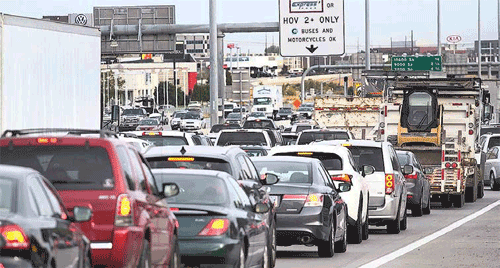Brice Wallace
A 1960s song described summer as “those lazy, hazy, crazy days,” but a group of Utah organizations are hoping to eliminate the “hazy” part.
The Salt Lake Chamber, the Utah Clean Air Partnership (UCAIR) and TravelWise Utah have teamed up for the 2023 Clear the Air Challenge, a month-long competition involving businesses, organizations and individuals. The goal is to reduce vehicle pollution and raise public awareness of the importance of clean air by driving less and driving “smarter” during{mprestriction ids="1,3"} July.
Participants are asked to avoid trips alone in their car and use TravelWise strategies such as carpooling, teleworking, taking public transit, biking or trip “chaining” (grouping errands into one trip). Transportation emissions are responsible for nearly half of the pollutants that make up the area’s poor air quality.
The website cleartheairchallenge.org contains program details, including the goals of eliminating 100,000 single-occupant trips in order to save 2 million miles traveled.
Last year, program participants eliminated 53,541 trips; saved more than 1 million miles; reduced carbon dioxide by 392.7 million tons; and saved about $600,000. The top large teams were Fidelity Investments, the state of Utah and the University of Utah. The top small teams were Dell Technologies-Utah, GSBS Architects and Penna Powers. Top individuals were David Vasquez, state of Utah; Alison Mortensen-Hayes, University of Utah; and Guinevere Timpson, state of Utah.
Since the program began in 2009, 1.38 million trips have been eliminated, more than 20 million miles saved, 6,733 tons of emissions reduced and nearly $8.6 million saved.
Program organizers say that by driving less and driving smarter, people can improve air quality, reduce traffic congestion and conserve energy in Utah. The program also can help protect people’s health because summertime chemical emissions react with sunlight and heat to create “summer ozone” that contaminates air quality.
The Utah Division of Air Quality has said that if all drivers living along the Wasatch Front were to park their cars just one day per week, vehicle emissions would be reduced by 6,500 tons per year.
Organizers have listed several benefits for businesses involved in the challenge. They include contributing to a healthier environment; showcasing their dedication to corporate social responsibility, which in turn can win customers; and lowering utility bills and operating costs by implementing energy-saving measures. Those measures also may make companies eligible for financial incentives, grants or tax credits, further enhancing their cost savings.
They also have said that having employees involved in carpooling, promoting telecommuting or supporting public transportation can help businesses foster a sense of purpose and pride among their workforce.{/mprestriction}








